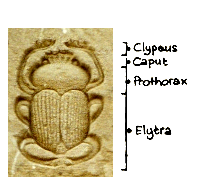
Der Name eines in Ägypten häufigen Käfers, 'Scarabaeus sacer', von den Ägyptern 'cheper' genannt, ein Wort, das auch 'werden' bedeutet. Dieses Tier, das seine Eier in eine Mistkugel legt, war für die Ägypter die Personifizierung selbsttätig entstehenden, aus der Erde entspringenden Lebens. Dies wurde mit der aus der Erde wiedergeborenen Sonne Chepre assoziiert, die häufig als Käfer oder als Mann mit einem Käfer als Kopf dargestellt wurde. Die Art, wie der Käfer die Mistkugel dahinrollte, wurde als Parallele zum Weg der Sonnenscheibe über den Himmel empfunden. Skarabäenfiguren wurden bereits im Alten Reich als Amulette verwendet. Anfangs waren sie unbeschriftet, aber vom Mittleren Reich an wurden sie als Siegel verwendet, indem in ihre flache Unterseite dekorative Motive oder Texte eingeritzt wurden. Viele Skarabäentexte enthalten den Namen eines Königs, aber da es üblich war, den Namen eines berühmten Königs der fernen Vergangenheit zu wählen, ist die Datierung oft problematisch. Amenophis III. aus der 18. Dynastie ließ eine große Zahl von Skarabäen herstellen, deren Texte wichtige Ereignisse wie die Heirat mit Königin Teje, eine Löwenjagd oder den Bau eines Sees verewigten. Eine besondere Art von Skarabäus ist der sogenannte Herzskarabäus, ein Amulett, das oft auf einer Seite wie ein Skarabäus, auf der anderen wie ein Herz geformt war. Dieser Gegenstand wurde zwischen die Mumienbinden gelegt oder an einer Kette um den Hals gehängt und sollte verhindern, daß das Herz beim Totengericht gegen den Verstorbenen aussage. Er war gewöhnlich mit einem Text aus dem Totenbuch beschriftet, der das Herz dazu aufrief, nicht gegen seinen Besitzer auszusagen. Es gab noch einen weiteren Typ Totenskarabäus, der häufig aus Fayence bestand und manchmal separat gefertigte ausgebreitete Flügel besaß. Sie wurden auf die Brust des Toten gelegt und am Mumiennetz befestigt.